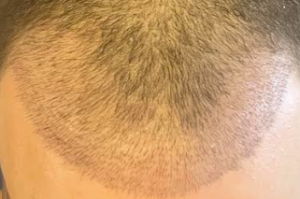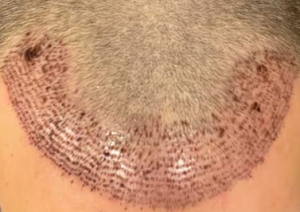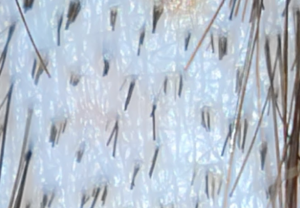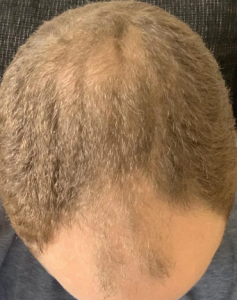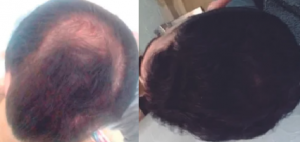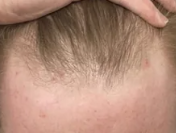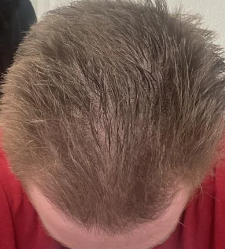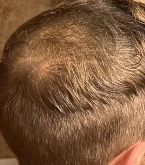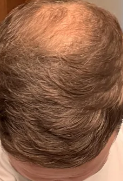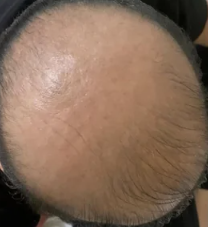Some doctors are so orderly that they line up hair grafts like toy soldiers when they do a hair transplant. Sometimes these patterns show in the final result. Here are two photos 2 days (on the right) and 2 weeks (on the left) from the date of his hair transplant. He is rightfully concerned. Since I posted this photo, I was given new photos of him at 5 months growth. The hair that lined up at the time of the surgery, can be seen now when you look at him. He wants me to fix it, an easy fix as I have done thousands of these. I advised him to wait until he is 8 months out before undergoing a repair surgery with me.
Good morning, I came across your balding blog and think that it’s a great resource. Thank you for doing that. I see people ask you all sorts of questions and I wasn’t sure how to post on there and/or ask something anonymously so I figured I would email you. I had alopecia on my scalp into which I had roughly 3,200 FUE grafts transplanted into the scar to conceal it (not all at once but in smaller separate procedures). I uploaded a picture of about a centimeter or so of my donor area where grafts were extracted and was wondering if you can from the picture help me estimate roughly how many grafts I still have left in my donor in case I want future transplants. I counted 32 follicular units and 78 hairs so that comes out to an average of about 2.4 hairs per unit. I tried doing the math I saw you explain on one of your threads and here is what I got. The average donor area is 12,500 units X 2.4 hairs = 30,000 hairs. You need roughly 12,500 hairs remaining in the donor area to provide adequate coverage so 30,000-12,500= 17,500 movable hairs. 17,500 hairs ÷ 2.4 hairs per graft equals 7,291 available grafts that I could move. That would have meant that before I used those 3,200 grafts for the scaring alopecia that I would have had a total of 10,491 harvestable grafts in my donor. Is that even possible?
Your donor density is higher than average. What you didn’t take into account is your hair thickness, a very important factor in determining your harvestable donor area. Remember, that there are only 50,000 follicular units on the head of which 20-25% of them are in the donor area. If you are thinking that you take out more than half or 2/3rds of your donor area hairs, you will be in trouble if you have fine hair, which I believe is your situation.
How many grafts were removed totally? Answer 3200. Were these all follicular unit grafts? Yes? Subtract that number from 12,500 total donor supply and the remaining follicular units and you get 9,200 graft remaining. If your hair is fine, the actual number of grafts that are available will be significantly less than if your have a coarse hair. Medium is somewhere in the middle. You might still have a significant donor reserve based upon the hair thickness of the donor hair provided that you hair isn’t fine as I suspect it is. Does this help?
1) In a previous email, you stated that you’ve removed a strip of skin/scar from elsewhere on the scalp aside from the usual donor area and extracted grafts from it; we had been talking about the temporal region since I had a scar there with grafts placed into it. Strips that are removed from the temporal region, do they typically heal well with minimal scaring?2) If grafts from a second procedure were placed on top of grafts that have yet to surface from a previous procedure, what will happen?3) People with diffuse patterned alopecia, do they eventually lose all the hair in the areas that they are thinning and end up with a slick bald scalp? Or does the hair remain but just is thin?
1- Grafts placed into a scar often have a lower survival than grafts placed into normal skin
2- If a graft was placed exactly on top of the stem cell from a transplanted graft that had not grown yet, it will still grow as well as the original graft, possibly very close together
3- Diffuse patterns of balding may remain, thin further, or go completely bald based upon the cause of the balding process
Any concern in SMP while on topical min fin? And what about a transplant with SMP on scalp?
Once the SMP is set (about 1 -2 weeks), the use of minoxidil is not a problem. if you had SMP and wanted a hair transplant, there should be no problem as any good surgeon should be able to work with SMP present.
If you develop hypertrichosis from minoxidil, stopping it will cause all of the minoxidil-grown hair to fall out. This may take a few weeks or even more than a month
If someone has a hair transplant procedure and 6-8 months later they have an additional transplant procedure, since it can take up to a year for all of the transplanted hairs to surface, what if in the 2nd procedure they place a graft in the same spot as a graft that has not grown yet from the 1st procedure?
Actually, by 8 months, 99% of the grafts that are growing have broken through the skin. Some telogen hairs may break through later on, but this is not a significant amount.
I am surprised that this man actually got some reasonable results from microneedling in what we refer to as Atrophic scalp, that is, a person’s scalp that hasn’t had hair for, in his case, 14 years. He used minoxidil and finasteride as well. This man got a response in just 3 months indicating that the stem cells are still viable.
What is the effect of minoxidil to the hair follicle? How can you tune the dosage to manifest the effects on hair?
I believe that you are referring to the test that determines if you have the enzyme that converts minoxidil to minoxidil sulfate in the scalp? If so, this is the test, I believe: https://www.danielalain.com/products/minoxidil-response-test-men
I fear I may have developed DUPA. My sides and back have become transparent and I am approaching an NW7. I have added oral fin, oral min, and topical pyrilutamide which I believe has helped and the oral min has regrown some hair and increased thickness a bit. But the density is still poor. I still experience some itching and tingling along my hair line, even for my beard which is patchy. I am wondering if there are natural anti-inflammatory treatments I can add to my regimen to combat loss from inflammation. Is there a such thing as a natural JAK inhibitor that may be gentle enough to help my DUPA?
I have read that for DUPA sufferers, inflammation is the cause of hair loss, where the immune system attacks all the hair follicles of the head. This seems relevant to me because right after a shower if I have scrubbed and dried my skin a lot, I notice a lot of puffiness, redness all over and tingling and itching and hair fall from my scalp and even beard. So I fear inflammation is attacking my hair. I have also suffered skin conditions like eczema resulting from inflammation in the past. I am afraid to try JAK inhibiting drugs to combat inflammation because they come with high risk of potentially deadly sides.
Your discussion was interesting to read. Please make sure that you have DUPA. This is what it looks like, so get a hand microscope and see if this is what you have: https://baldingblog.com/classic-case-of-dupa/
21, ftm transgender man, got double mastectomy at 19 and telogen effluvium from the surgery triggered ongoing hair problems. ive been on topical minoxidil for about a year and i think it’s helped somewhat (i didnt take progress pictures because i was incredibly embarrassed about my situation). my dermatologist is thinking about oral minoxidil, especially since i’m going through my first finasteride shed rn. but i know that oral min can cause body hair growth and that’s causing a lot of hesitation for me. i really prefer to be androgynous irl (dunno why exactly, i just feel most comfortable that way) and hate being too hairy, i got my beard lasered off when i turned 18. i have dark hair on my legs and arms and a trail on my stomach but that’s really it and i’m happy with that amount. i really don’t want chest or back hair. i value having a mix of masculine and feminine traits and i feel like too much hair would tip the scales too much. but at the same time i obviously want to get the best results possible for my head hair. so i’m just trying to weigh my options. will oral min cause new body hair growth or just thicken hair thats already there? or is it a case-by-case basis? would keeping it on a low dose be worth it? i know for a fact that i’m an outlier on this sub, i’ve never seen any posts approaching hair loss from a similar position of wanting to maintain some femininity, so i don’t expect to hear from very many people in the same boat if at all. but info from people who know more about oral min than me, or just any advice or encouragement, would be really helpful.
This is a real concern that you have. Small doses of minoxidil might cause an increase in your body hair. If you try it, these hairs will be dependent upon minoxidil so when you stop it, these hairs should fall out. It is a real risk, but I doubt a permanent gain in hair will be the result of any experimentation you do. there are many good alternatives for preventing hair loss on your head, so this should be managed by a good, knowledgable doctor.
Page 49 of 1234

